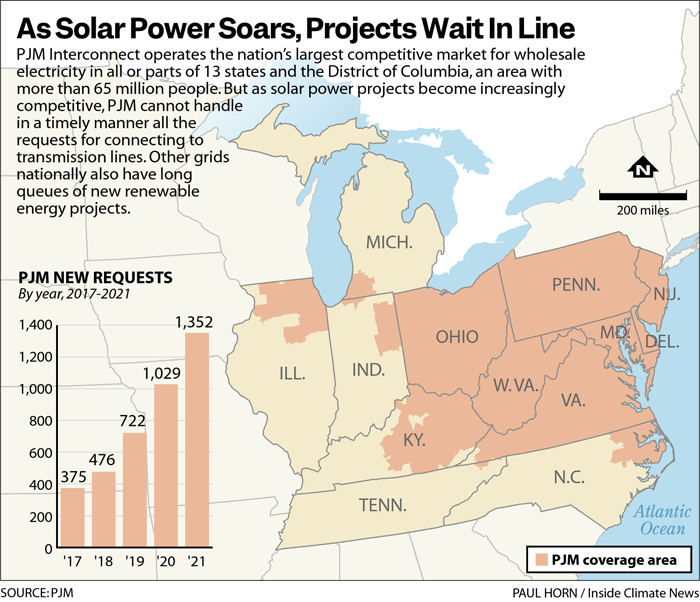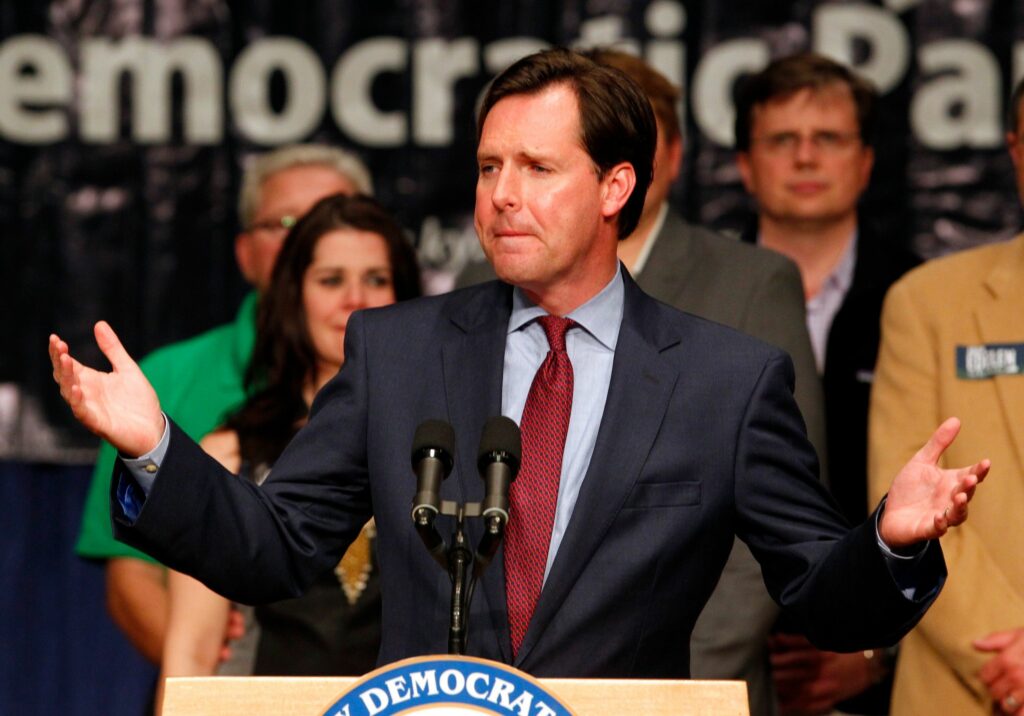|
Inside Climate News
Clean
Energy
Overwhelmed
by Solar Projects, the Nation’s Largest Grid Operator Seeks a Two-Year
Pause on Approvals
“It’s a kink in the system,” says one developer trying to bring solar
jobs to coal country. “The planet does not have time for a delay.”

By
James Bruggers

Power lines in West Reading,
Pennsylvania, February 2021. Credit: Ben Hasty/MediaNews Group/Reading
Eagle via Getty Images
“It’s a kink in the system,”
said Adam Edelen, a former Kentucky state auditor who runs a company
working to bring solar projects and jobs to ailing coal communities in
Appalachia, including West Virginia, Pennsylvania, Ohio, Virginia and
Kentucky. “Anyone paying attention would acknowledge that this has a
tremendous impact on climate policy and energy policy in the United
States.”
The backlog at PJM is a
major concern for renewable energy companies and clean energy
advocates, even though grid operators are a part of the energy economy
that is largely unknown to the public.
“There is broad national
consensus, in the leadership from the public and the private sector,
that we need to hasten the adoption of renewable energy,” Edelen said.
“The planet does not have time for a delay.”
PJM, a nonprofit, operates a
competitive market for wholesale electricity in all or part of 13
states and the District of Columbia, including Pennsylvania, West
Virginia and Kentucky—but one without a lot of renewable energy. Wind,
solar and hydropower plants make up about 6 percent of its
distribution mix.

Over the last four years,
PJM officials said they have experienced a fundamental shift in the
number and type of energy projects seeking to be added to a grid that
extends from Virginia to northeast Illinois, each needing careful
study to ensure reliability.
In the past, PJM’s energy
project queue was dominated by a few large projects like big natural
gas power plants. Now, PJM officials said, they are receiving a
proliferation of smaller projects, each needing study.
“Our system wasn’t designed
to handle that kind of growth,” said Kenneth S. Seiler, vice president
of planning at PJM.
About 2,500 projects are
awaiting action by the grid operator, which is based in Valley Forge,
Pennsylvania, outside Philadelphia.
PJM officials are proposing
a two-phased solution.
They want to move to a new
approval process that puts projects that are the most ready for
construction at the front of the line, and discourages those that
might be more speculative or that have not secured all their
financing.
PJM officials said they have
reached a reasonable consensus among their members for that plan.
However, they are also
proposing an interim period with a two-year delay on about 1,250
projects in their queue, and a deferral on the review of new projects
until the fourth quarter of 2025, with final decisions on those coming
as late as the end of 2027.
“We are taking a pause,”
Seiler said of the grid operator’s proposal. “We are refining the
process to deal with these smaller types of projects. We will catch
up.”
The United Nations
Intergovernmental Panel on Climate Change last summer
issued the first installment of its latest global warming
assessment, prompting UN Secretary-General António Guterres to
describe
the work as nothing less than “a code red for humanity.”
Still, Seiler said he’s not
certain whether PJM can attain the Biden goal of achieving 100 percent
carbon-free electricity by 2035. PJM in December
announced a study looking at how it could boost renewable energy
mix to 50 percent by 2035. With nuclear energy in the region factored
in, that could get the PJM grid to about 60 to 70 percent carbon free,
he said.
“We’re not sure, frankly,
quite yet, because we’re still studying it, if we can get there, 100
percent renewable by 2035,” Seiler said. “But I can tell you, we’re
taking a real hard look at it.”
“The Process Right Now Is
Effectively Broken”
PJM has established a
task force to work its proposal through committees of its members,
including electric utilities and energy developers. By May, officials
hope to submit it to the Federal Energy Regulatory Commission, which
has final say.
With so much money at stake
in a policy with the potential to help make financial winners and
losers, experts say they expect whatever FERC decides may end up in
court.
National studies show grid
operators across the country have a growing queue of energy projects,
many that do not pan out and actually clog up the system. In 2021, the
Lawrence Berkeley National Laboratory
found that only 24 percent of projects nationally seeking
connection from 2000 to 2015 were built, and completion percentages
since then appeared to be declining.
Last year, Americans for a
Clean Energy Grid, a national group advocating for modernization of
high voltage transmission, made the case in a
report that backlogs were “needlessly increasing electricity costs
for consumers by delaying the construction of new projects which are
cheaper than existing electricity production. Because most of these
projects are located in remote rural areas, this backlog is harming
rural economic development and job creation.”
How PJM resolves its backlog
could have implications for the rest of the country, said Jeff Dennis,
managing director and general counsel for Advanced Energy Economy, a
trade group for clean energy businesses.
“PJM has traditionally been
a bellwether,” he said. “Things that PJM puts into place and that FERC
approves for PJM often become models for other regions,” he said.
A lot is at stake, he added.
“Delayed interconnection
queues and backlogs in bringing new generation on is one of the most
significant barriers to state clean energy policies and the jobs and
economic development that states are aiming to achieve through
transitioning their grids to advanced energy technologies,” he said.
But “folks should be
encouraged that there was wide stakeholder support for many, many
aspects of PJM’s still-developing generator interconnection process,”
Dennis said.
PJM’s efforts to cope with
and efficiently manage the backlog have the support of Justin Vickers,
staff attorney for the Environmental Law & Policy Center, a
Chicago-based environmental advocacy group.
“I hear from developers all
the time that PJM’s queue is such a mess that it’s putting their
ability to get projects done in jeopardy, and it’s creating
uncertainty in getting projects up and running,” he said. “Trying to
find a way out of this mess is good.”
He compared what PJM is
doing with traffic metering lights at freeway onramps. “What it’s
actually doing is managing the congestion to smooth things out. It
feels like you should just get there as fast as you can. You shouldn’t
have to pause in order to get on the highway. But actually it’s better
for everyone if you do, even if it might be slightly worse for you,
the individual traveler.”
Ohio-based utility AEP has,
within the PJM territory, wind and solar projects proposed for
Virginia and is also seeking to add renewable energy to its mix in its
Indiana Michigan Power territory, said company spokeswoman Tammy
Ridout. She said company officials expect those projects “are largely
already in the PJM queue.”
She said AEP supports “the
changes that PJM is putting in place to help improve the process,
including prioritizing projects that have financing and other key
aspects secured so those can move forward first.”
At PJM and other grid
operators across the country, “the process right now is effectively
broken,” said Gizelle Wray, senior director of regulatory affairs and
counsel for the Solar Energy Industries Association, a trade group.
While she acknowledged that
some of the association members are happy with what PJM has proposed,
she said that others are not, adding: “This is as fair of an outcome
as we could possibly get.”
Solutions are needed beyond
what PJM has proposed, she said, adding that the association hopes
FERC will move the country toward better transmission and
interconnection policies.
“We need solutions that make
sure this doesn’t happen anymore,” Wray said.
A FERC spokesman did not
return requests for comment.
Coal Communities Need
Investment
The length of the PJM
backlog varies by state. For example, in Pennsylvania, where Gov. Tom
Wolf in 2019 set his state’s first statewide greenhouse gas reduction
goals, 520 energy projects are currently in the queue, 437 of which
are solar. Virginia, which adopted powerful renewable energy portfolio
standards for electric utilities in 2020, has 417 solar projects in
the queue. Kentucky and West Virginia have been slow to adopt solar
but those states have 110 and 57 solar projects, respectively,
awaiting approval by PJM.
In Kentucky, Edelen ran for
governor in 2019 in part on a
platform that the state needed to embrace the reality of climate
change and adapt the state’s coal-dependent economy, but lost in the
Democratic Primary to Gov. Andy Beshear. He said he understands PJM’s
situation and that much of what it has proposed makes sense.

Adam Edelen, former state auditor
during his unsuccessful campaign for Kentucky governor. Credit: John
Sommers II /Special to the Courier Journal
His company, Edelen
Renewables, is a
partner in a 200-megawatt solar project on a former strip mine in
Martin County, Kentucky, that he says is far enough along that it
won’t be affected by PJM rule changes. But in January he
announced
a joint venture with a 200-year-old West Virginia company, The
Dickinson Group, with its extensive land holdings, including mine
sites, that Edelen said could lead to several new solar farms.
He said he fears those
efforts will face years’ long delays as PJM works through its backlog,
and he said he’s frustrated that the transition to a new energy
economy hinges on the actions of a vital but relatively little-known
organization.
In addition to retooling its
approval process, PJM should increase the size of its staff to meet
the demand and urgency for renewable energy, Edelen said.
“Staffing is an issue,”
conceded Seiler.
But Seiler said qualified
engineers would need to be found. And then, he said, “it takes several
years to train somebody to do a lot of this work.”
Edelen said that just as
climate solutions can’t wait, according to the latest science, neither
can coal communities.
“I believe we can fight
climate change and revitalize forgotten American communities,” he
said. “A be-patient approach from (PJM) administrators is not
something I agree with.”
Inside Climate News
reporter Dan Gearino contributed to this report.
Green Play Ammonia™, Yielder® NFuel Energy.
Spokane, Washington. 99212
www.exactrix.com
509 995 1879 cell, Pacific.
Nathan1@greenplayammonia.com
exactrix@exactrix.com
|